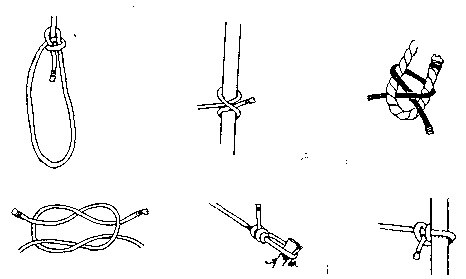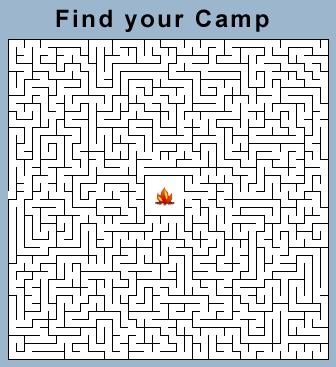Webelos Outdoorsman Activity Badge Worksheets
Knotty Knots
Knot DescriptionsMatch each description on the left to the appropriate knot name on the right.
| For tightening and loosening a rope easily and on guy lines. | xxxxx | Square Knot |
| For tying a rope to a post or ring; it's strong but easy to loosen. | Tautline Hitch | |
| For tying a rope to a tree or post. | Clove Hitch | |
| Used when you want a loop that
will not slip or close up; used for rescue work. |
Sheet Bend | |
| For tying two ropes together and for tying bandages in first aid. | Bowline | |
| For tying two ropes together, especially when one is thicker than the other. | Two Half Hitches |
Forget-Me "Knots"
Draw a line from the knot name to the correct picture.| Square Knot | Tautline Hitch | Clove Hitch |
| Sheet Bend | Bowline | Two Half Hitches |

If You're Lost in the Woods
Fill in the blanks with a word from this list. All words should be used once.| dry fire head hole leaves nightfall run sheltered signal wander |
|
Fire Safety
Mark each True statement with T and each False statement with F
|
Checklist for a Perfect Campsite
Place a checkmark in front of every item that is needed for the perfect campsite:|
____ Sheltered by trees to the west and north ____ Open to avoid danger of falling branches ____ Sheltered from prevailing winds ____ Open to expose tents to early morning sun ____ Sheltered from prying eyes of nosy neighbors ____ Open to afford a pleasant view ____ Elevated to avoid morning fog ____ Low to avoid harassment of mountain lions ____ Sloped for drainage of water ____ Level for a comfortable night's sleep ____ Abundant in wildlife and nature ____ Devoid of insects, snakes, skunks, p-ivy ____ Grass covered to absorb rain ____ Sparsely vegetated to avoid grass fires ____ Stocked with wood for fuel and projects ____ Cleared of all stumps, sticks, logs, brush ____ Private (forget highway median strips) ____ Close to home ____ Safe from flash floods (buffalo stampedes) ____ Well supplied with water for drinking, swimming, fishing, boating and even washing. |
Wood for Campfires
There are three types of wood used to build a fire. Use the following key to decode them.| D | E | F | G | I | K | L | N | R | T | U |
| $ | @ | % | ? | * | | | + | & | = | - | # |
___ ___ ___ ___ ___ ___
- * & $ @ =
___ ___ ___ ___ ___ ___ ___ ___
| * & $ + * & ?
___ ___ ___ ___
% # @ +<
Types of Wood
Fill in the blanks with the appropriate answer from the above puzzle.|
____________ can be anything that is light and dry and not thicker than a match. Make little bundles of tiny twigs. ____________ should snap when broken. In general, dead branches from lower limbs of trees are best to use. Sticks lying on the ground could be damp ____________ includes sticks that are not green. Use these only after a hot fire is started. |
Just For Your Information:
| * Wood that crumbles is rotten. It will smolder and smoke without giving off heat. * Split wood burns well. The inside of a log is drier than the outside. * Soft wood (produced by trees that grow quickly such as pines, spruces, cedars, gray birch, aspen) burns quickly. It is good for starting fires or for quick, hot fires. It does not leave good coals. * Hard wood (produced by trees that grow slowly such as oaks, hickories, yellow birch, maples, and ash) burns slowly. It leaves good coals that will last. |
Camping Maze

|
Outdoorsman Word Search